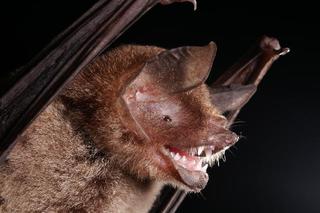
Original source: Entry on Pteronotus parnellii at BOLD Systems - Image
Author: Alex Borisenko, Biodiversity Institute of Ontario
Parnell's mustached bat
Order : Chiroptera
Family : Mormoopidae
Species : Pteronotus parnellii
The Parnell's mustached bat is listed as Least Concern (LR/lc), lowest risk. Does not qualify for a more at risk category. Widespread and abundant taxa are included in this category, on the IUCN Red List of Threatened Species
Namings for the Parnell
A young / baby of a Parnell is called a 'pup'. A Parnell group is called a 'colony or cloud'.Countries
Belize, Bolivia, Brazil, Colombia, Costa Rica, Dominican Republic, El Salvador, French Guiana, Guatemala, Guyana, Haiti, Honduras, Jamaica, Mexico, Nicaragua, Panama, Peru, Puerto Rico, Saint Vincent and the Grenadines, Suriname, Trinidad and Tobago and Venezuela
Facts about the Parnell's mustached bat
The basilar membrane itself in the mustached bat, Pteronotus parnellii is thickened precisely at the frequencies that the bat is most interested in, 61.
Pteronotus parnellii is the only member of its family (indeed, the only bat in the New World) to use Doppler shift echocation. (Full text)
However, the overlap in Pteronotus parnellii is not merely a constraint of timing because it occurred irrespective of the rate of repetition or duty cycle and was not significantly different between flying and resting vocalisation (Lancaster et al. (Full text)
If you don't wish to use JavaScript, please visit our frame-based site Narrow space fluttering hunters Pteronotus parnellii is our narrow-space fluttering hunter and its echolocation strategy is to emit in the 60Khz range and use the doppler effect to detect objects which are moving. (Full text)
Tamana bat virus (TABV, isolated from the bat Pteronotus parnellii) is currently classified as a tentative species in the genus Flavivirus. (Full text)
More animals beginning with P
